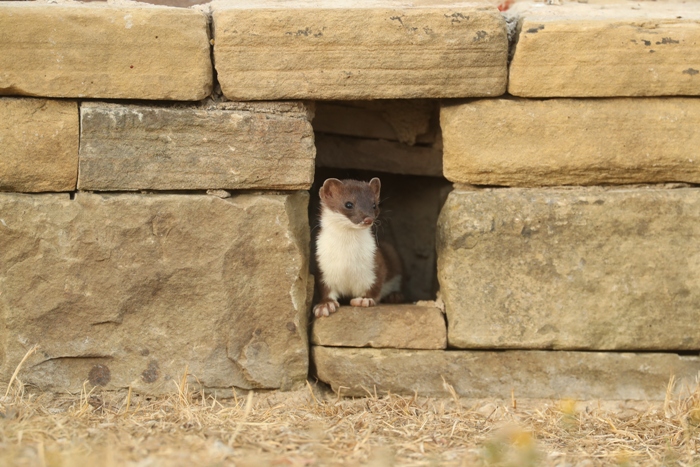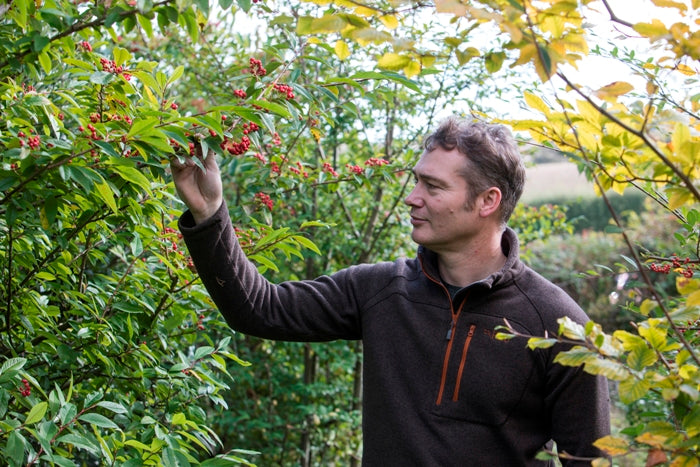Wildlife artist Robert E Fuller tours the wildlife garden he designed 20 years ago and points out stoats, sparrowhawks, kestrels and owls living in the trees and shrubbery. After two decades, this Yorkshire wildlife garden now provides a constant source of inspiration for his art.
It is now 20 years since I moved to Fotherdale Farm in Thixendale and in all my time here I’ve never known such a warm October. One particularly balmy day I opened my studio doors to let in some fresh air. As I did so I spotted a red kite, swirling high on shifting thermals above the valley. While I watched it, my attention was distracted by a movement below.
A kestrel lives in my wildlife garden
A kestrel had landed on a feeding tower. I built the tower specifically for this kestrel and it was satisfying to see it tucking in to a meal I had left there. The kestrel is an old friend of mine, a male that has nested in my garden for 11 years and whom I have nicknamed Mr Kes. I’ve painted his portrait many times. I leave food for Mr Kes on this tower every day so that when he visits I can photograph him against the Yorkshire Wolds valley that stretches behind it – this gives me a beautiful backdrop for any new potential paintings.


After watching Mr Kes feeding for a moment, I turned back to the painting on my easel. The composition features 19 tree sparrows, all balanced on one branch. I chose to paint it because it tells the story of my 20 years at Fotherdale better than any other: when I moved here there was just one pair of tree sparrows and now, after planting trees, native shrubs and bushes, and digging nine ponds, there are 35 breeding pairs here. Read more on the development of my wildlife garden by clicking here.
Tree sparrows thrive in my wildlife garden
Suddenly the real tree sparrows on my bird feeder began to call out in alarm and I was again distracted. They took off in a noisy, clamorous cloud. I noticed they then began tucking themselves into the dense branches of a holly bush. I looked up. A male sparrow hawk was circling the holly. It flew once-round and then settled on the bird feeder. As it landed its piercing, yellow eye connected momentarily with mine. Then it was off again, swooping effortlessly over the hedge and down the valley.


Surveillance cameras keep track of visitors to my wildlife garden
I glanced at a bank of TV monitors next to my easel. These screens relay live images from surveillance cameras in my garden back to my studio. I wanted to see where the sparrowhawk was going, but he had flown out of range of the cameras. Instead a young barn owl caught my eye on the neighbouring screen. It was roosting inside a nest box. I originally put that box up in my garden for kestrels, but this barn owl seemed to have adopted it. It blinked lazily and then began to carefully preen its feathers.
Stoats and weasels live in my wildlife garden
My attention was distracted by a movement on the next screen. Here was Crackle, a female stoat. Crackle was born in April right here in my garden. She was nosing along a drystone wall I had built as a backdrop to photograph stoats and weasels against, looking for titbits of food that I usually leave for her. I never miss an opportunity to photograph this stoat. Almost an adult, her mother is now trying to push her out of the territory and so each time I see her could be the last.

 I rushed down the stairs, out through a secret underground tunnel that leads from my living room to my hide and quickly began to snap a run of photographs. I built this tunnel especially so that I can get to my hide without being detected by the wildlife in the garden. So far it’s been a great way of getting really close to the animals that live here. Once Crackle had gone, I headed back up the tunnel, using a pulley to drag a wheeled trolley I use to transport myself through the length of the tunnel, back through the space.
I rushed down the stairs, out through a secret underground tunnel that leads from my living room to my hide and quickly began to snap a run of photographs. I built this tunnel especially so that I can get to my hide without being detected by the wildlife in the garden. So far it’s been a great way of getting really close to the animals that live here. Once Crackle had gone, I headed back up the tunnel, using a pulley to drag a wheeled trolley I use to transport myself through the length of the tunnel, back through the space.A wildflower meadow provides a larder for the birds in my wildlife garden
As I stood up again I spotted a charm of goldfinches feeding on seed heads in the meadow below the house. I sowed the seed for this meadow in 2006 and it has provided a larder for the birds here ever since. At this time of year most of the plants have set seed but I notice there are a few knapweed and yarrow flowers remaining to provide nectar for the insects that still hummed over the field, in spite of how late it was in the season.
I planted a woodland in my wildlife garden
In the distance I could hear a black bird. It was making a continuous, chinking sound: the call blackbirds make when they want to warn of a predator approaching. I decided to investigate. The sound was coming from my wood behind the gallery. As I walked towards it, I noticed a fieldfare perched high on one of the trees. It flew off as I got closer and joined a flock passing overhead. A wood pigeon also lifted off its nest and clattered through the trees.

 I returned my attention to the sound of the blackbird’s noisy calls. I looked up and noticed a male tawny owl peering down at me from a larch tree. So this was what was bothering the blackbird. As I looked up at the owl I thought about how, 12 years ago, I planted the tree it was now roosting in. Behind the larch is a yew with an old song thrush nest in it. Both trees were among a delivery of 1,200 saplings that I dug in to the hillside behind the gallery in the hope of creating a windbreak as well as a place for birds and wildlife to thrive. Click here to read more about how I developed my Fotherdale Forest.
I returned my attention to the sound of the blackbird’s noisy calls. I looked up and noticed a male tawny owl peering down at me from a larch tree. So this was what was bothering the blackbird. As I looked up at the owl I thought about how, 12 years ago, I planted the tree it was now roosting in. Behind the larch is a yew with an old song thrush nest in it. Both trees were among a delivery of 1,200 saplings that I dug in to the hillside behind the gallery in the hope of creating a windbreak as well as a place for birds and wildlife to thrive. Click here to read more about how I developed my Fotherdale Forest.It was time to head back to my easel. As I retraced my steps, I heard a bullfinch’s soft contact call. Then I picked out the sharper tone of a redpoll. Redpolls are relatively rare here, but they feed on the alder trees in my woodland most winters. It is so heartening to see how my ‘Fotherdale Forest’, as I like to call my miniature woodland, has taken off and is now sustaining so much life.

 Back at my studio, I noticed there was now a barn owl perched on the kestrel’s feeding tower, reminding me that it was almost time to put food out for the owls. I feed tawny owls and barn owls from a post outside my living room every night. This year I am feeding seven barn owls. It is especially rewarding to see them since it took me 16 years to get barn owls to nest here.
Back at my studio, I noticed there was now a barn owl perched on the kestrel’s feeding tower, reminding me that it was almost time to put food out for the owls. I feed tawny owls and barn owls from a post outside my living room every night. This year I am feeding seven barn owls. It is especially rewarding to see them since it took me 16 years to get barn owls to nest here.When I moved to Fotherdale 20 years ago there was barely any bird life here and the only wild life was the occasional fox or deer that slunk across the nearby fields. Now the site teams with wildlife, including the owls, kestrels and stoats I had just spotted on my brief walk from my studio to the woodland and back.
Enjoying my wildlife garden
I am usually so busy working and developing new areas for wildlife in my garden that I don’t take the time to appreciate what I have achieved. But this year I am celebrating my 20th anniversary at Fotherdale Farm in Thixendale with an exhibition of paintings of the wildlife I have watched on my doorstep since I moved here. I’ll be looking back at how I worked to transform the once-barren plot into a haven for wildlife and showing some of my favourite paintings of the wildlife I have encouraged to live here through a new display of art, photographs and video.
My new exhibition runs from November 10th - December 2nd. Click here for more information and an idea of what to expect.
https://www.robertefuller.com/wildlife-art-exhibition-celebrates-20-years-on-the-yorkshire-wolds/






1 comment
Great stuff Robert. Beautiful pictures, beautiful stories and beautiful paintings as usual. You make my heart sing. Keep those brushes going! And congratulations on the fantastic results of your labours in creating a garden of Eden for wildlife. I am jealous!